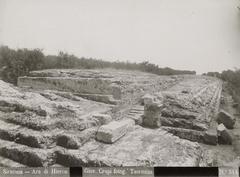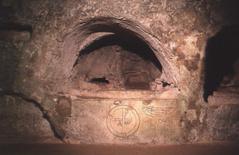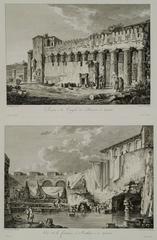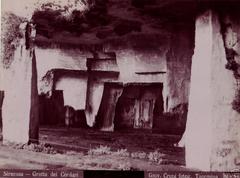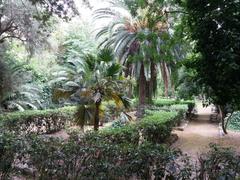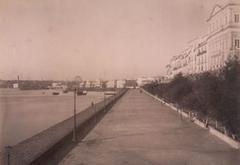
Catacombs in Syracuse, Italy: Visiting Hours, Tickets, and Historical Sites Guide
Date: 04/07/2025
Introduction: The Catacombs of Syracuse—History and Cultural Significance
The catacombs of Syracuse, Italy, are among the Mediterranean’s most remarkable early Christian burial sites, second in scale only to those of Rome. Rooted in the city’s profound Greek and Roman heritage, these subterranean cemeteries offer visitors a unique window onto the origins and evolution of Christianity in Sicily. The Basilica of St. John the Evangelist (San Giovanni Evangelista) and its catacombs—primarily developed between the 4th and 6th centuries AD—stand as enduring witnesses to Syracuse’s religious transformation, architectural ingenuity, and layered cultural legacy.
Ingeniously reusing an ancient Greek aqueduct, the catacomb network features interconnected galleries and burial chambers that served as sacred burial grounds and places of worship, and provided refuge during times of persecution. Within this labyrinth, sites like the crypt of St. Marcianus (the city’s first bishop) and the Sarcophagus of Adelfia exemplify the blend of pagan and Christian funerary traditions. Today, with guided tours in multiple languages and practical visitor resources, the catacombs are a highlight for history lovers. Nearby attractions—including the Archaeological Park of Neapolis and the Cathedral of Syracuse—enrich any cultural itinerary. This detailed guide provides all essential information for planning a successful and meaningful visit to the catacombs of Syracuse (Spotting History; Italia Like a Local; Hermes Sicily).
Contents
- Early Christian Origins and the Birth of the Catacombs
- Architectural Evolution and Layout
- The Basilica of St. John: Layers of History
- The Crypt of San Marciano
- Funerary Practices and Artistic Heritage
- Modern Significance and Rediscovery
- Visiting Information: Hours, Tickets, Tours, and Tips
- Accessibility and Photography
- Nearby Attractions and Practical Travel Advice
- Frequently Asked Questions (FAQs)
- Summary and Recommendations
- References
Early Christian Origins and the Birth of the Catacombs
The catacombs beneath the Basilica of St. John the Evangelist are intimately linked to the earliest Christian communities in Syracuse. According to tradition, St. Marcianus, sent by St. Peter in 39 AD, was the city’s first bishop and is believed to be buried in the crypt under the basilica, making this site a central focus for devotion and burial (Spotting History). The earliest catacombs, such as Santa Lucia, date to the 1st and 2nd centuries AD. The Catacombs of St. John expanded primarily during the 4th and 5th centuries, as Christianity gained legal recognition under Roman rule and burial outside city limits became common practice (Algilà Hotel Guide).
Architectural Evolution and Layout
The catacombs were ingeniously adapted from a former Greek aqueduct, with their layout mirroring a Roman military camp (castrum). The “decumanus maximus” is the main gallery, from which ten secondary galleries (cardines) branch off at right angles. At the ends of these galleries are four large circular chapels—once water cisterns—named Antioch, Marina, Adelfia, and Sarcophagi, which later became communal burial spaces. The walls are lined with rectangular loculi (individual tombs) and arcosolia (arched recesses for families or guilds), all cut into the living rock (Spotting History).
The Basilica of St. John: Layers of History
Constructed by the Byzantines in the 6th century atop St. Marcianus’s crypt, the Basilica of St. John was Syracuse’s largest religious building of its time. The Normans rebuilt it in the 12th century, reusing materials from the Temple of Demeter and Kore, altering its orientation, and reconstructing the presbytery. It suffered heavy damage during the 1693 earthquake and was partially restored in 1705. The 1908 earthquake left the basilica roofless, creating the evocative open-air ruin visitors see today (Spotting History).
The Crypt of San Marciano
A staircase to the right of the basilica entrance leads down to the crypt of San Marciano, about five meters below street level. This crypt preserves Byzantine architectural elements such as apses and pavements, while Norman additions include four marble capitals depicting the Evangelists and decorative frescoes. The crypt served as a major pilgrimage site and a center of Christian worship (Spotting History).
Funerary Practices and Artistic Heritage
The catacombs of Syracuse provide a rare glimpse into early Christian funerary rituals. Tombs such as the “refrigerium” were used for funeral banquets, blending pagan and Christian traditions. The Sarcophagus of Adelfia, now in the Paolo Orsi Archaeological Museum, is one of the most significant artifacts—depicting scenes from the life of Christ and illustrating the evolution of Christian iconography. Numerous inscriptions in Greek and Latin document the multicultural heritage and social structure of ancient Syracuse (Algilà Hotel Guide).
Modern Significance and Rediscovery
Although parts of the catacombs remain unexplored, modern archaeological research has revealed their vast complexity. Rediscovered and studied over the past two centuries, the catacombs are a testament to the resilience and creativity of Syracuse’s early Christian community, and they remain a site of religious significance and cultural pride (Spotting History).
Visiting Information: Hours, Tickets, Tours, and Tips
Locations and Access
- Catacombs of San Giovanni: Located beneath the Basilica di San Giovanni, near the Neapolis Archaeological Park.
- Catacombs of Santa Lucia: Beneath the Basilica Santuario di Santa Lucia al Sepolcro, in Piazza Santa Lucia.
- Catacombs of Vigna Cassia: Along Via Von Platen (currently closed to the public).
Visiting Hours
- San Giovanni Catacombs: Open year-round except for a brief closure in January and February. Typical hours are Tuesday–Sunday, 9:30–12:30 and 14:30–16:30. From November 11, open mornings only: 9:30–12:30. Closed Mondays and during the winter closure (Hermes Sicily).
- Santa Lucia Catacombs: Open primarily in peak season or by group appointment. Confirm availability in advance.
Tickets and Booking
- Tickets: Entry is by paid ticket, which includes the mandatory guided tour. Prices range from €5 to €10, with discounts for students, seniors, and groups.
- Booking: Advance booking is strongly advised, especially during peak season. Reserve via the managing cooperative (Hermes Sicily) or at the entrance.
Guided Tours
- All visits are by guided tour, typically lasting 30–45 minutes, offered in Italian and often English (other languages may be available).
- Tours include the basilica ruins, crypt, and key catacomb highlights.
Accessibility and Photography
- Physical Accessibility: The catacombs are underground, with steps, narrow passageways, and uneven floors—generally not wheelchair accessible.
- Lighting: Low lighting is used to protect frescoes and artifacts; bring a light jacket for the cool underground temperature.
- Photography: Photography is generally prohibited to preserve the environment and respect the site’s sanctity. Always follow guide instructions (Hermes Sicily).
Nearby Attractions and Practical Travel Advice
- Neapolis Archaeological Park: Home to the Greek Theatre, Roman Amphitheatre, and the Ear of Dionysius.
- Paolo Orsi Archaeological Museum: Houses artifacts from the catacombs and wider Syracuse area.
- Cathedral of Syracuse: A masterpiece of Baroque architecture on the island of Ortigia.
- Travel Tips: Wear sturdy shoes, arrive early, and bring water, especially in summer. The historic center is best explored on foot, with public transport and parking available nearby.
Frequently Asked Questions (FAQs)
Q: What are the visiting hours for the Syracuse catacombs?
A: San Giovanni catacombs are open Tuesday–Sunday, typically 9:30–12:30 and 14:30–16:30, with seasonal variations. Santa Lucia catacombs are open mainly during peak season or by appointment.
Q: How do I book tickets?
A: Tickets are available at the entrance or online via the managing cooperative. Guided tours are required.
Q: Are the catacombs wheelchair accessible?
A: No, access involves stairs and narrow passages.
Q: Can I take photographs inside?
A: Photography is generally prohibited.
Q: Are guided tours available in English?
A: Yes, often available—request your preferred language when booking.
Q: How long does a typical visit last?
A: Guided tours last about 30–45 minutes.
Summary and Recommendations
A visit to the catacombs of Syracuse is a journey through early Christian history, remarkable architecture, and Sicily’s unique cultural heritage. The sites beneath the Basilica of St. John and other historic churches reveal a story of faith and resilience, preserved in intricate burial layouts and rare artistic remains. Practical considerations—such as guided tours, ticketing, changing opening hours, and accessibility—ensure a safe and rewarding experience. For a comprehensive Syracuse adventure, combine your catacomb tour with the Neapolis Archaeological Park, the Cathedral, and the Paolo Orsi Museum. For up-to-date information and travel planning, consult official tourism platforms and the Hermes Sicily Catacombs Timetable or download the Audiala app. The Syracuse catacombs stand as both silent witnesses to centuries of history and vibrant gateways for modern discovery (Spotting History; Hermes Sicily; Italia Like a Local).
References
- Basilica of St. John Catacombs in Syracuse: History, Visiting Hours, Tickets & Travel Tips, 2024, Spotting History (https://www.spottinghistory.com/view/10358/basilica-and-catacombs-of-st-john/)
- Visiting the Main Catacombs of Syracuse: Tickets, Hours & Historical Insights, 2024, Italia Like a Local (https://www.italialikealocal.com/what-to-see-in-siracusa/)
- Exploring the Syracuse Catacombs: Visiting Hours, Tickets, and Historical Insights, 2024, Algilà Hotel Guide (https://www.algila.it/post/visit-the-syracuse-catacombs?lang=en)
- Visiting the Syracuse Catacombs: Hours, Tickets, Tours, and Travel Tips, 2024, Hermes Sicily (https://www.hermes-sicily.com/blog/en/27-opening-times-sicily/462-syracuse-catacombs-timetable)






